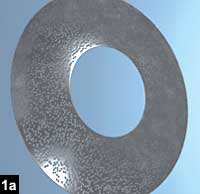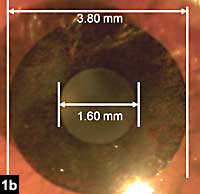Holladay: Depth of field, pinhole effect are important optical principles
The third installment of reports from the OSN Section Editor Summit.
A note from the editors:

Ocular Surgery News convened its annual Section Editor Summit in February. In this third installment of reports from the summit, Optics, Refraction and Contact Lenses Section Editor Jack T. Holladay, MD, MSEE, FACS, discusses the optical principles behind depth of field and the pinhole effect.
I would like to discuss the AcuFocus ACI 7000 ultrathin intracorneal inlay, which utilizes a principle that we call depth of field, or the pinhole effect.
This is something that Daniel S. Durrie, MD, first presented 2 years ago at the American Society of Cataract and Refractive Surgery meeting.
There are actually two technologies we have on the market that utilize depth of field: the crystalens, from eyeonics, and the AcuFocus, which was recently purchased by Bausch & Lomb.
 Jack T. Holladay |
The AcuFocus is a small, 10-µm-thick corneal inlay, with a 1.6-mm inner diameter that gets centered over the pupil. It has a 3.8-mm outside diameter and about 1,800 tiny fenestrations between 10 µm and 12 µm in the annulus surrounding the pinhole, allowing glucose metabolism and other corneal nutrients to diffuse normally.
There have been approximately 250 of these implanted over the last 2 years, 75 in the United States and the remainder around the world. Of those outside the United States, the visual results have been positive: 20/15 at distance, 20/15 at near, no effect on contrast sensitivity and no effect on visual field.
Now, you might look at these results and wonder how one can get a pinhole to do all that and not have any adverse effect. In Figures 1a and 1b, one can see some of the light coming through and the exterior diameter of the outer diameter of the inlay. The principle is that it is centered over the pupil so that it creates a depth of field.
On a diffraction curve, as the pupil gets larger, our vision should get better. And with a 7-mm pupil, it should be the best possible vision we have, but it is not.
Even though our vision should get better as the pupil gets larger, it does not. The optical aberrations prevent us from achieving the best vision as the pupil gets larger. Because we have optical aberrations in the human eye, the optimal vision occurs when the pupil is between 2 mm and 3 mm.
The best recorded visual acuity is 20/8. The potential retinal vision is 20/5.
crystalens
The diameter of the crystalens is 4.5 mm, compared with 6 mm for standard IOLs. The improvement in near vision experienced by patients implanted with crystalens can be explained by depth of field. A 4.5-mm optic should have 25% more depth of field than a 6-mm optic. This equates to around 1.5 D of pseudoaccommodation and explains the enhanced near vision with this lens.
|
Images: Holladay JT |
Important optical principle
I believe depth of field is a significant optical principle that we are already utilizing today with existing technology.
At least two technologies today – the crystalens and AcuFocus – are already utilizing depth of field and the pinhole effect. At 20/16 at distance and near for 98% of these patients, this is a bar that is going to be hard to beat in the near future. This principle gives you distance and near vision without halos or other issues.
Of course, if you have a blue iris, one drawback is that when you look from the side, your pupil sometimes looks a bit off. But most people do not even notice, and it is worth the downside to be able to see well at distance and near.
Flap thickness
For the AcuFocus, the flap should be around 160-µm thick because if the flap is too thin and you place something foreign under it, the patient does not do well over time.
So far, these have been implanted in emmetropes who have not undergone previous refractive treatments, as mandated by the U.S. Food and Drug Administration requirements.
But there is potential here for presbyopic patients who have had LASIK and who have a flap over 140-µm thick to lift the flap, place the inlay over the pupil and replace the flap.
This could also help reduce aberrations within the 4-mm zone, although this is not an indication we are currently working on.
For more information:
- Jack T. Holladay, MD, MSEE, FACS, is a clinical professor of ophthalmology at Baylor College of Medicine. He can be reached at Holladay LASIK Institute, Bellaire Triangle Building, 6802 Mapleridge, Suite 200, Bellaire, TX 77401; 713-668-7337; fax: 713-668-7336. Dr. Holladay has no direct financial interest in the products mentioned in this article.
- Bausch & Lomb, maker of the AcuFocus ACI 7000, can be reached at 1400 N. Goodman St., Rochester, NY 14609; Web site: www.bausch.com. eyeonics inc., maker of the crystalens IOL, can be reached at 6 Journey, Suite 125, Aliso Viejo, CA 92656; 949-916-9352; fax: 949-916-9359; Web site: www.eyeonics.com.


